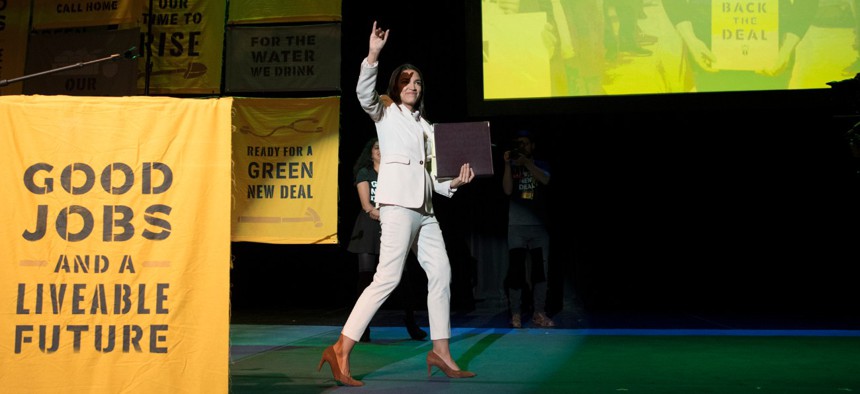
Rep. Alexandria Ocasio-Cortez, D-N.Y., speaks at the final event for the Road to the Green New Deal Tour att Howard University in Washington in May. Cliff Owen/AP
One Way to Make the Green New Deal Actually Happen: a Super-Ministry
To administer the Green New Deal, combine Interior, Energy, Housing & Urban Development, and Transportation to create a new Department of Cities and Regions.
One month after Donald Trump took office, erstwhile presidential consigliere Steve Bannon remarked that an overriding goal of the White House was the “deconstruction of the administrative state.”
From the unprecedented amount of unfilled appointments in federal agencies to the elimination of rafts of regulatory directives, the Trump White House has made significant strides towards achieving this objective. If a Democrat defeats Trump and enters the White House on January 20, 2021, she or he will face an administrative challenge unprecedented for either major political party in recent history.
The deepening crisis of federal bureaucracy is a useful lens to see how policy and administration can more effectively repair the divides that characterize our politics. The United States is no longer a country of merely blue states and red states. It is a mosaic of blue cities and red prairies. Our fractured politics are the result of the geographic inequalities that produce these divisions.
The Green New Deal is the most ambitious proposal the Democratic Party is discussing to address these inequalities. But to implement it successfully, the agencies most likely to be involved should be reorganized by an incoming administration into one “super-ministry,” a department that would enable the federal government to administer the policies most effectively.
The Green New Deal is a framework of public investment to transform the United States’s infrastructure in order to halt climate change and support struggling communities. The need to address the stark inequalities between places is built into the Green New Deal’s policy DNA.
While the Green New Deal proposal is still mostly conceptual at this point, the basics are relatively clear: investments to shift the energy grid to renewable sources, research and development for new technologies, retrofitting existing buildings and underground infrastructure, and major investments in public housing and transportation. But in order to make this a reality, the devil is in the details of the “administrative state.” This means those same institutions and regulations that have been in the cross-hairs of the Trump administration.
Administrative overhauls can be vital for breaking through the inertia that infects bureaucracy over time, especially once many agencies have been gutted. My proposal is a reorganization of the agencies that are likely to be involved in planning and financing the Green New Deal: Interior, Energy, Housing & Urban Development, and Transportation. This super ministry—a Department of Cities and Regions—would strengthen the power of the federal government to undertake the institutional changes required.
A key policy plank of the Green New Deal is to achieve net-zero building standards. This can be realized through a program that finances municipal governments to build millions of new rental housing on the basis of these standards. Elizabeth Warren has filed a bill in the Senate that would provide public financing for building over 2.1 million new homes in 10 years. Progressive think tanks and academics have called for the building of up to 10 million homes in the same time period to help alleviate the well-documented affordable housing crisis, particularly for the growing number of renters. The last time this high a share (44 percent) of Americans were renting rather than owning homes was in the 1960s. This was also the last time the United States saw any kind of significant public investment in housing. Today, 38 percent of renters are rent-burdened, meaning that they spend more than 30 percent of their monthly income on rent.
Scaling up investment in social housing within the Green New Deal framework has clear advantages for building an effective political coalition. First, it would strengthen the power and security of the growing share of Americans who are renters. Second, it would build popular support for perpetually underfunded municipal public housing authorities. And finally, it would appeal to building trades unions who are currently skeptical of the Green New Deal framework, fearing that it would put them out of work on fossil
fuel-related infrastructure.
A Department of Cities and Regions would be able to direct funding streams for housing, energy, and transportation infrastructure to be managed through municipal governments. Essentially, this would make available local-level finance tied to national goals. Municipalities are well-placed to prioritize new investments due to their knowledge of local needs and priorities. For those municipalities without effective planning capacity, the federal government could provide technical assistance. Furthermore, municipalities are more likely to avoid malign competition, for example, through tax breaks to multinational corporations like Amazon. They would be assured of sufficient federal financing for local priorities that are not generally funded by their own revenues.
These seemingly dry administrative reforms have the potential to stitch together the United States’s political social contract. Local government is where it should be easiest for Americans to make their voices heard. But the lack of meaningful federal funding for cities, since at least the early 1980s, has depoliticized local politics. Civic leaders of all political stripes pursue private investment with increasingly divisive social effects. Ordinary citizens often do not have clear choices on the distributional questions of local public goods, like housing, that make participation meaningful.
Financial and planning empowerment of municipalities through a Department of Cities and Regions would raise the stakes of local politics, unlocking a new era of local political participation and experimentation. Bold policies will need to be coupled with a commensurate vision for administering them.






